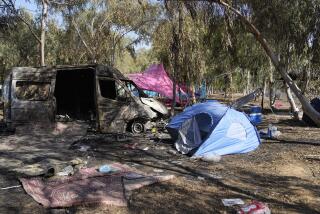Call Polanski’s crime what it was: rape
- Share via
The Times’ Oct. 25 article, “How a girl’s stark words got lost in the Polanski spectacle,” is yet another piece about Roman Polanski’s crimes that purports to be tough on the film director but instead adds to the public perception that what he did was no big deal.
First, the story refers to the crime as an “alleged” rape. Polanski pleaded guilty to “unlawful sex with a minor,” which is the crime of child rape in California. There is no need to use the word “alleged” anymore.
The story also, incredibly, includes references to the victim’s utterly irrelevant two past sexual incidents before her encounter with Polanski. At a minimum, The Times should have noted that, according to a report by Polanski’s probation officer, one time was with a teenage boyfriend and another was at age 8 with a “kid down the street.” The piece creates a false impression that the victim was sexually mature with adult men.
These things may be salacious to the reader, but they are completely irrelevant as a matter of law -- thus irrelevant to the story -- not to mention constitutionally protected private information that diminishes the seriousness of the crime. A child cannot consent to adult sex, which makes all information about the victim’s past particularly irrelevant. But even if she had been over the age of consent, past sexual activity has no bearing on whether a victim consented on the night in question. Thus, to write such things about a child is indefensible. To do so in a story that purports to reveal the awful truth about Polanski manipulates the public sentiment.
And what could possibly justify writing that a member of the grand jury who heard the victim’s testimony thought she was “fast”? What if one of them thought Polanski was “ugly,” a “pedophile” or “gay-looking”? Would The Times have printed that?
The story also leaves out important information about Polanski’s predatory actions. For example, the pieces of Quaalude he gave the child were from a 300-milligram tablet -- which makes even a small piece super-potent, especially to a young girl. Medical literature says kids shouldn’t have the drug at all; the effects are even worse after a few glasses of champagne, which Polanski gave to his victim.
The story says Polanski’s probation report “scrubbed” the allegations against him but doesn’t mention that what Polanski told investigators flatly contradicts what the victim and her mother told the grand jury. Polanski told his probation officer that he didn’t know it was wrong to photograph a child topless; this even though, according to testimony by the victim’s mother, Polanski didn’t reveal the fact that he photographed her daughter topless until after the rape had taken place. He said the girl took off her blouse on her own volition, but the victim testified that Polanski directed her to remove her clothes. Polanski also said he didn’t offer her any Quaaludes; again, the victim’s testimony contradicts this claim. She said Polanski told her to take the drug.
Despite the probation officer’s odd support for Polanski (his report noted, stunningly, that Polanski was “solicitous” in avoiding impregnating the child), it was recommended that he not be around children under age 18. The Times’ article left this out too.
Most important, the piece uses extensive erotic language and barely any language of violence. The word “rape,” which is what Polanski did to the child, appears only four times (twice because The Times was quoting someone else). “Rape” is the only word that clearly conveys criminal activity, and a child can never have “sex” with an adult.
Wendy Murphy, a former prosecutor specializing in child abuse and sex crimes cases, is the author of “Justice for Some.”
More to Read
A cure for the common opinion
Get thought-provoking perspectives with our weekly newsletter.
You may occasionally receive promotional content from the Los Angeles Times.









